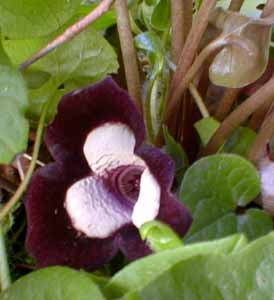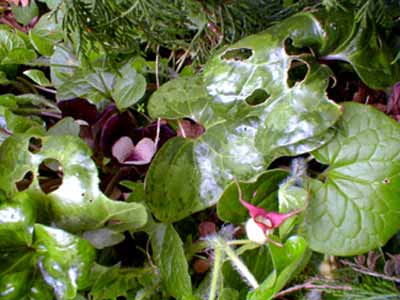 Giant Wild Ginger:
Giant Wild Ginger:
Asarum delavayi
We have at last count five kinds of wild ginger; three are native, two are not. Three varieties are growing all around the shaded base of an Alaska Weeping Cedar. Two of the Native Wild Gingers are discussed separately on the Asarum canadense page, the A. caudatum page, & a popular cultivated variety is discussed on the A. shuttleworthii "Callaway" page.
Except for A. canadense which is smallest of the four & deciduous, these wild gingers have proven to be evergreen or nearly so. Some I planted in 1999, others were planted in 2001, & the giant one shown on this page (A. delavayi or Chinese Giant Wild Giner) we planted at the start of Spring 2002.
Asarums in general can be slow to establish so don't necessarily look like much immediately, though I enjoy them a great deal even before they start to become an impressive groundcovers. A. delavayi turned out not to be quite so slow to establish as the others & was already a thick spreading groundcover by its second year. By comparison the "Callaway" asarum has spread only a little bit in five years, & A. caudatum spent two years just establishing good roots before it began to spread.
 The first photo was taken in March (2004), attempting to get a good shot of one of the big flowers, which are numerous this time of year, but hidden underneath the enormous leaves. Some of the blooms will dangle out into the open around the edges of the spreading clumps, but you'd never guess there was a large number of these blooms without lifting up the leaves here & there.
The first photo was taken in March (2004), attempting to get a good shot of one of the big flowers, which are numerous this time of year, but hidden underneath the enormous leaves. Some of the blooms will dangle out into the open around the edges of the spreading clumps, but you'd never guess there was a large number of these blooms without lifting up the leaves here & there.The second photo, also from March, shows a couple of snail-nibbled leaves which are from the previous year's growth, but still quite attractive. New leaves will be refreshing the clump throughout spring. The more perfectly rounded leaf in this photo, & the smaller almost alien-looking triple-tendril-lipped seed-urn, are from A. caudatum, as the patches of these two species have been impinging into one anothers' spaces
Throughout spring it will be producing fresh leaves, but so many of the previous year's growth remains that it is sometimes necessary to get in there & clip out any leaves that are looking warn. If not tended to at all, however, it does do pretty darned well taking care of itself.
 The species is named after Pere (Father) Jean Marie Delavay (1834-1895), shown here in a little portrait. We also have in our garden a Chinese Meadow Rue named for him, Thalictrum delavayi.
The species is named after Pere (Father) Jean Marie Delavay (1834-1895), shown here in a little portrait. We also have in our garden a Chinese Meadow Rue named for him, Thalictrum delavayi.He was a French Jesuit missionary who first arrived in China in 1867. He collected plants for Adrien Franchet of the National Museum of Natural History in Paris (& for whom our Franchet's Cotoneaster is named). Pere Delavay travelled alone in distant mountainous regions of Yunnan, seeking plants of potential interest to gardeners in Europe. His efforts resulted in an extravagant collection of four-thousand species, of which 1,500 were previously unknown to western botanists.
This Chinese asarum was not introduced to the US nursery market until the year 2000. The glossy, mottled leaves of the Giant Wild Ginger can reach ten inches across, one of the biggest of all asarums. It's not easy to photograph asarum flowers because they hide under leaves directly on the ground in darkest shadow, but if you look closely, you'll see a big flower which I tried to expose for the photo by moving the sheltering leaves aside.
The bloom is quite an amazing thing, cream-colored down the throat, dark chocolate velvet on the upper inside of petals, & knubbly-hard on the outside. These sit on the ground because they are pollinated by crawling ants & beetles. I've seen moths fly out of asaram blooms, so it's not just crawling things that help it along.
The blooms smell like dung to attract their pollinators, not that anyone ever smells one unless first getting down on ones tummy to stick ones nose right in it. And this bizarre bloom is just about big enough to get ones nose completely inside! In many species the flowers dry out, turn brown or grey, & last the rest of the year as a dried cup. But the Giant's flowers decay in May.
Asarum caudatum